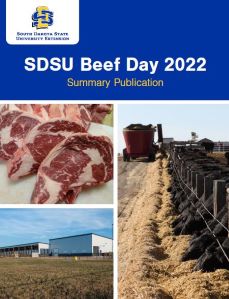
SDSU Beef Day 2022 Summary Publication
Document Type
Article
Publication Date
1-19-2022
Abstract
Study Description:
Within 10 herds, beef females (n = 1,620) were either: 1) not synchronized (NonSyn) and mated to bulls, 2) synchronized (7-d controlled internal drug release (CIDR)) and mated to bulls (SynNS) 3) synchronized (7-d CO-Synch plus CIDR) and artificially inseminated with conventional semen (SynAI), or 4) synchronized (7-d CO-Synch plus CIDR) and artificially inseminated with SEXED semen. Calving distributions (calves born from d 1 to 14, 1 to 21, 22 to 42, and 43 and greater) were determined by actual birthdates and calf gender was determined at birth. Over a two-year period, a subset of calves (n = 508) born to cows subjected to the previously discussed reproductive treatments in each of the 10 herds were fed to reach a target backfat (BF) of 0.50 inches, sent to harvest, and carcass data were collected. Calves were classified into calving groups as natural service born early (NS-Early, n = 189), natural service born late (NS-Late, n = 203), or AI sired born early (AI-Early, n = 116). Early was defined as the first 21 days of the calving season.
Pages
8
Publisher
South Dakota State University
Rights
© 2022 South Dakota Board of Regents
Recommended Citation
Walker, Julie; Rich, Jerica J.J.; Rusche, Warren; Diersen, Matthew; and Perry, George, "Effect of Estrous Synchronization With Natural Service or Fixed-Timed Artificial Insemination Using Conventional or Gender-Kkewed Semen in Beef Females on Calving Distribution and Post Weaning Calf Performance" (2022). SDSU Beef Day 2022 Summary Publication. 9.
https://openprairie.sdstate.edu/sd_beefday_2022/9
